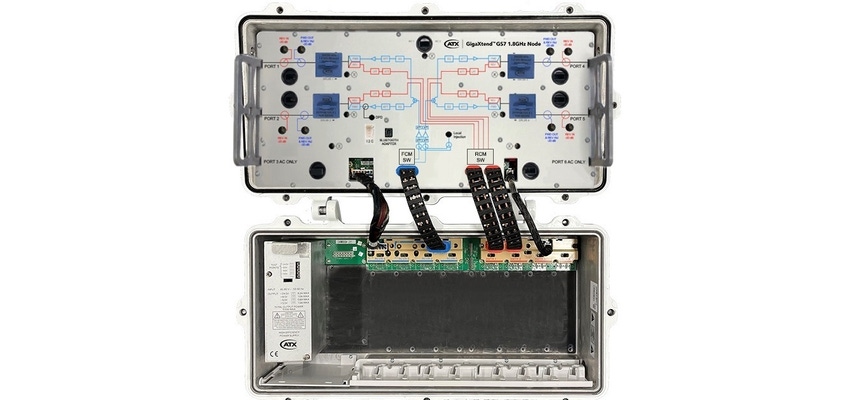ATX plots upgrade path to DOCSIS 4.0
ATX Networks has introduced a DOCSIS 4.0-capable 1.8GHz node that can be deployed as a standalone or dropped in to upgrade tens of thousands of legacy Cisco GS7000 nodes that have been deployed in North America and Latin America.

ATX Networks has set its sights on cable's DOCSIS 4.0 transition with a new 1.8GHz node platform that can be deployed as a standalone or as a swap-out kit that can upgrade tens of thousands of legacy Cisco GS7000 (GS7) nodes deployed in regions such as North America and South America.
The near-term priority and focus for the new GigaXtend GS7 1.8GHz Node will center on updating the innards of legacy Cisco GS7 node housings that operators are keen to upgrade for the new distributed access architecture (DAA) and, potentially, DOCSIS 4.0, Jay Lee, ATX's chief technology and strategy officer, explained.
Lee said the GS7 is one of the few widely deployed nodes that have the space and heat dissipation capabilities to accommodate DOCSIS 4.0 drop-in upgrades.
That approach aims to save operators both time and money. "You don't have to switch out any of the housing, which is plumbed into the network, from a coaxial standpoint and a fiber connectivity standpoint," Lee said. "It's huge from a cost standpoint and labor standpoint ... It's so much quicker."
ATX's new node and drop-in upgrade kits will support hybrid fiber/coax (HFC) network bandwidth upgrades up to 1.8GHz (up from legacy networks equipped with up to 1GHz or 1.2GHz of capacity) and "mid-split" and "high-split" upgrades that dedicate more spectrum to the HFC upstream and pave a path toward symmetrical broadband services.
ATX has also designed the GigaXtend GS7 1.8GHz Node to support remote PHY devices (RPDs) from Vecima Networks and Harmonic. That integration will enable support for DAA, a requirement for future DOCSIS 4.0 networks. ATX is also exploring a plan to develop its own DOCSIS 4.0 RPD.
DAA nodes such as ATX's are also designed to support nodes with PON modules for targeted fiber-to-the-premises (FTTP) deployments, including new rural buildouts.
Availability slated for first half of 2024
ATX will offer its first glimpse of the GigaXtend GS7 1.8GHz Node later this month at the SCTE Cable-Tec Expo in Denver. The supplier expects the new node to become available in the first half of 2024, and to primarily be manufactured at a new plant in Grand Blanc Township, Michigan, developed in partnership with Mara Technologies/Invotek. That will help to position ATX to support the Build America, Buy America requirements linked to the Broadband Equity Access and Deployment (BEAD) program.
ATX hasn't announced any operator commitments for trials or deployments for the GigaXtend GS7 1.8GHz Node, but Lee said a Tier 1 US operator is eager to start rolling it out.
There's no shortage of domestic cable operators that are upgrading HFC networks with the desire to employ drop-in upgrades over wholesale node switch outs. Some potential candidates with deployed GS7s that are pursuing DOCSIS 4.0 and/or DAA network upgrades include Cox Communications, Rogers Communications and Charter Communications.
Cisco GS7 nodes are also present on Comcast's HFC network, but the operator is going in a different direction. Rather than upgrading to 1.8GHz with the Extended Spectrum version of DOCSIS 4.0, Comcast is going with the Full Duplex (FDX) option that will use a lower bandwidth ceiling and employ an FDX band that allows upstream and downstream traffic to occupy the same block of spectrum.
Cisco tech expertise
ATX bills the new node as the only "authorized successor" to the Cisco GS7. Its new 1.8GHz platform takes shape more than three years after ATX licensed Cisco's GainMaker amplifier platform. ATX has also hired a team of former Cisco and Scientific-Atlanta engineers, including some original designers of the GS7000 and GainMaker platforms.
UPDATE: In late 2022, ATX wrapped a separate technology licensing agreement that covered Cisco's GS7 and Prisma II platforms in the wake of Cisco's decision to end-of-life those products.
Those moves give ATX a critical knowledge base and a unique perspective on the design and lifecycle of the GS7 platform, providing an edge as operators look to upgrade those nodes with drop-in kits, Lee said.
But ATX won't be alone in that pursuit. For example, Applied Optoelectronics (AOI) has sparked a plan to develop 1.8GHz products that can be sold as drop-in upgrades for Cisco GainMaker and GS7000 node products. Technetix is also exploring the drop-in upgrade opportunity for legacy Cisco gear, and recently appointed Cisco engineering exec and DOCSIS pioneer John Chapman to its strategic advisory board.
About the Author(s)
You May Also Like












